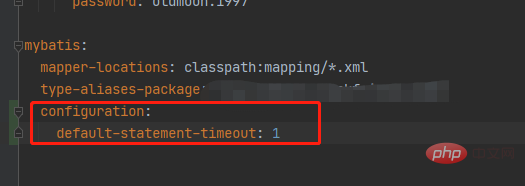
Recommended (free): SQL
Zero, database driver
- The MySQL driver helps us connect to the database at the bottom level. Only after the connection is established can subsequent interactions be possible.
1. Database connection pool
- Database connection pools include Druid, C3P0, and DBCP
- Using connection pools saves a lot of money The overhead of constantly creating and destroying threads is the famous "pooling" idea. Whether it is a thread pool or an HTTP connection pool, you can see its presence
2. SQL interface
- The thread that processes the request in MySQL obtains the SQL statement after obtaining the request and hands it to the SQL interface for processing.
3. Query parser
- #Parses the SQL statement passed by the SQL interface and translates it into a language that MySQL can understand.
4. MySQL Query Optimizer
- MySQL will choose to use the corresponding index based on the minimum cost principle #Cost = IO cost CPU cost
- IO cost: That is, the cost of loading data from disk to memory. By default, the IO cost of reading a data page is 1, MySQL reads data in the form of pages. That is, when a certain data is used, it will not only read this data, but also read the data adjacent to this data into the memory. This is a famous program. The principle of locality, so MySQL will read a whole page each time, and the cost of one page is 1. Therefore, the cost of IO is mainly related to the size of the page
- CPU cost: After reading the data into the memory, it is also necessary to detect whether the data meets the conditions and the cost of sorting and other CPU operations. Obviously it is related to Depending on the number of rows, by default, the cost of detecting records is 0.2. MySQL optimizer will calculate the "IO cost CPU" index with the smallest cost to execute
5. Storage engine
- The query optimizer will call the storage engine interface to execute SQL, which means that the actual
- execution of SQL is completed in the storage engine. Data is stored in memory or disk
- Every time SQL is executed, its data will be loaded into memory. This memory is a very important component in InnoDB. :
- Buffer Pool
The executor finally goes according to a series of execution plans Call the storage engine interface to complete the execution of SQL

Buffer Pool ( Buffer Pool) is a very important memory structure in the InnoDB storage engine. It plays the role of a cache.
- Buffer Pool means that when we query for the first time, we will store the query results in the Buffer Pool, so that later When there is another request, it will first be queried from the buffer pool. If there is no search, it will be searched on the disk, and then placed in the Buffer Pool.
- The data used in the Buffer Pool will be locked.
-

1. Undo log file
: before the recorded data is modified Appearance
Function: Use undo log files to complete transaction rollback
: Record the appearance of the modified data
redo records the value after the data modification, regardless of whether the transaction is submitted or not.- MySQL In order to improve efficiency, these operations are It is first placed in memory to complete. The updated data will be recorded in the redo log buffer, and then persisted to disk at a certain opportunity.
-

Record the entire operation process
bin log records the entire operation record (this is very important for master-slave replication)
Property
redo Log
bin Log
File size
The size of the redo log is fixed (it can also be set in the configuration, generally the default is enough)
bin log can be set for each # through the configuration parameter
max_bin log_size ##bin logThe size of the file (but it is generally not recommended to modify it).
Implementation method
redo log
is implemented by the InnoDB engine layer (that is to say, Innodb storage causes excessive Yes)
bin log
is implemented by the MySQL layer, and all engines can use bin loglog
to record Method
redo log records in a loop writing method. When writing to the end, it will return to the beginning to write logs in a loop. bin log is recorded by appending. When the file size is larger than the given value, subsequent logs will be recorded to new files
Usage scenarios
redo log
Suitable for crash recovery (crash-safe) (this is actually very similar to the persistence feature of Redis)
bin log
Suitable for master From replication and data recovery
The above is the detailed content of Execution of a SQL statement. For more information, please follow other related articles on the PHP Chinese website!
 SQL Server使用CROSS APPLY与OUTER APPLY实现连接查询Aug 26, 2022 pm 02:07 PM
SQL Server使用CROSS APPLY与OUTER APPLY实现连接查询Aug 26, 2022 pm 02:07 PM本篇文章给大家带来了关于SQL的相关知识,其中主要介绍了SQL Server使用CROSS APPLY与OUTER APPLY实现连接查询的方法,文中通过示例代码介绍的非常详细,下面一起来看一下,希望对大家有帮助。
 SQL Server解析/操作Json格式字段数据的方法实例Aug 29, 2022 pm 12:00 PM
SQL Server解析/操作Json格式字段数据的方法实例Aug 29, 2022 pm 12:00 PM本篇文章给大家带来了关于SQL server的相关知识,其中主要介绍了SQL SERVER没有自带的解析json函数,需要自建一个函数(表值函数),下面介绍关于SQL Server解析/操作Json格式字段数据的相关资料,希望对大家有帮助。
 聊聊优化sql中order By语句的方法Sep 27, 2022 pm 01:45 PM
聊聊优化sql中order By语句的方法Sep 27, 2022 pm 01:45 PM如何优化sql中的orderBy语句?下面本篇文章给大家介绍一下优化sql中orderBy语句的方法,具有很好的参考价值,希望对大家有所帮助。
 Monaco Editor如何实现SQL和Java代码提示?May 07, 2023 pm 10:13 PM
Monaco Editor如何实现SQL和Java代码提示?May 07, 2023 pm 10:13 PMmonacoeditor创建//创建和设置值if(!this.monacoEditor){this.monacoEditor=monaco.editor.create(this._node,{value:value||code,language:language,...options});this.monacoEditor.onDidChangeModelContent(e=>{constvalue=this.monacoEditor.getValue();//使value和其值保持一致i
 一文搞懂SQL中的开窗函数Sep 02, 2022 pm 04:55 PM
一文搞懂SQL中的开窗函数Sep 02, 2022 pm 04:55 PM本篇文章给大家带来了关于SQL server的相关知识,开窗函数也叫分析函数有两类,一类是聚合开窗函数,一类是排序开窗函数,下面这篇文章主要给大家介绍了关于SQL中开窗函数的相关资料,文中通过实例代码介绍的非常详细,需要的朋友可以参考下。
 如何使用exp进行SQL报错注入May 12, 2023 am 10:16 AM
如何使用exp进行SQL报错注入May 12, 2023 am 10:16 AM0x01前言概述小编又在MySQL中发现了一个Double型数据溢出。当我们拿到MySQL里的函数时,小编比较感兴趣的是其中的数学函数,它们也应该包含一些数据类型来保存数值。所以小编就跑去测试看哪些函数会出现溢出错误。然后小编发现,当传递一个大于709的值时,函数exp()就会引起一个溢出错误。mysql>selectexp(709);+-----------------------+|exp(709)|+-----------------------+|8.218407461554972
 springboot配置mybatis的sql执行超时时间怎么解决May 15, 2023 pm 06:10 PM
springboot配置mybatis的sql执行超时时间怎么解决May 15, 2023 pm 06:10 PM当某些sql因为不知名原因堵塞时,为了不影响后台服务运行,想要给sql增加执行时间限制,超时后就抛异常,保证后台线程不会因为sql堵塞而堵塞。一、yml全局配置单数据源可以,多数据源时会失效二、java配置类配置成功抛出超时异常。importcom.alibaba.druid.pool.DruidDataSource;importcom.alibaba.druid.spring.boot.autoconfigure.DruidDataSourceBuilder;importorg.apache.
 如何在Python中根据运行时修改业务SQL代码?May 08, 2023 pm 02:22 PM
如何在Python中根据运行时修改业务SQL代码?May 08, 2023 pm 02:22 PM1.缘起最近项目在准备搞SASS化,SASS化有一个特点就是多租户,且每个租户之间的数据都要隔离,对于数据库的隔离方案常见的有数据库隔离,表隔离,字段隔离,目前我只用到表隔离和字段隔离(数据库隔离的原理也是差不多)。对于字段隔离比较简单,就是查询条件不同而已,比如像下面的SQL查询:SELECT*FROMt_demoWHEREtenant_id='xxx'ANDis_del=0但是为了严谨,需求上需要在执行SQL之前检查对应的表是否带上tenant_id的查询字段


Hot AI Tools

Undresser.AI Undress
AI-powered app for creating realistic nude photos

AI Clothes Remover
Online AI tool for removing clothes from photos.

Undress AI Tool
Undress images for free

Clothoff.io
AI clothes remover

AI Hentai Generator
Generate AI Hentai for free.

Hot Article

Hot Tools

Dreamweaver Mac version
Visual web development tools

MinGW - Minimalist GNU for Windows
This project is in the process of being migrated to osdn.net/projects/mingw, you can continue to follow us there. MinGW: A native Windows port of the GNU Compiler Collection (GCC), freely distributable import libraries and header files for building native Windows applications; includes extensions to the MSVC runtime to support C99 functionality. All MinGW software can run on 64-bit Windows platforms.

MantisBT
Mantis is an easy-to-deploy web-based defect tracking tool designed to aid in product defect tracking. It requires PHP, MySQL and a web server. Check out our demo and hosting services.

Atom editor mac version download
The most popular open source editor

Notepad++7.3.1
Easy-to-use and free code editor








